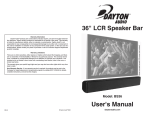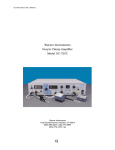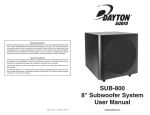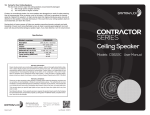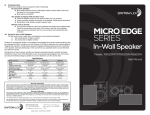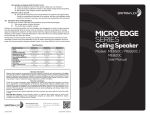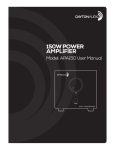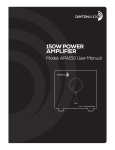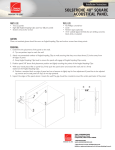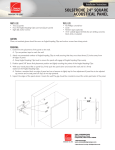Download User`s Manual AcT Acoustic Wall Panels
Transcript
Warranty Information Dayton Audio® products are constructed by industry experts, and are thoroughly tested before shipment. Dayton Audio® products are warranted for the period of five years. This warranty is limited to manufacturer defects, either in materials or workmanship. Dayton Audio® is not responsible for any consequential or inconsequential damage to any other unit or component, or the cost for installation or extraction of any component of the audio system. In the rare case of a product failure, please contact your place of purchase or call our Customer Support Department at (937) 743-8248. AcT Acoustic Wall Panels Warranty Limitations There are no other warranties, either express or implied, which extend the foregoing, and there are no warranties of merchantability or fitness for any particular purpose. The warranty does not cover incidental or consequential damage due to defective or improper use of products, or normal product wear and tear. This warranty gives you specific legal rights and you may also have other rights which vary from state to state. User's Manual ACT-08 © 2008 Dayton Audio® daytonaudio.com Thank you for purchasing Sonic Barrier AcT Acoustic Wall Panels by Dayton Audio. An acoustic wall panel’s purpose is to attenuate and eliminate audio reflections that occur when a sound wave bounces off an adjacent wall, which then arrives to a listener as delayed, incorrect audio information. Impaling clips (pictured) are designed to help hold panels in place until adhesive dries. Mount impaling clips to wall surface using sheet rock screws, threaded lag shields or appropriate fastener. Clips should be 4-6 inches from edges of panel to avoid fabric on back of panel. 22.5” x 22.5” panels use 3 clips; 22.5” x 45” panels use 4 clips. When placed correctly in a room, Sonic Barrier AcT acoustic wall panels provide holographic imaging and a noticeable improvement in frequency response. Two 1-1/2” thick panel sizes are offered: 22-1/2” x 22-1/2” and 22-1/2” x 45”. The smaller of the two panel sizes is designed to offer reflection attenuation without dominating a room’s décor. For dedicated listening rooms and home theaters, the larger panels offer greater frequency attenuation and maximum coverage. In addition to helping you to achieve a more satisfying audio experience, the AcT acoustic wall panels are designed to complement a room’s aesthetic. Each wall panel has been covered in simulated suede to provide a subtle touch that adds ambience to any room. A Word About Speaker Placement Imaging is a term commonly used to describe a psychoacoustic effect created by stereo two-channel speakers. When properly set-up, two speakers can recreate the sonic conditions captured within a recording: left to right musician placement, front to rear soundstage depth, and acoustic room effects (such as the echo from a concert hall). Speaker placement, for maximum imaging, should form an equilateral triangle relative to the seating location. Apply a “picture frame” of adhesive about 1” from the edge of the panel and as “S” of adhesive in the center of the panel. For added stability, apply glue to the tips of the clip. Position each panel in the correct location, and press onto the clips using the palm of your hand or a flat surface to spread force. Acoustic Panel Placement Use of a laser pointer (not included) to assist in the correct placement of the Sonic Barrier AcT acoustic wall panels is preferred. Place a laser pointer against the speaker baffle parallel to the floor (the front of the speaker). Aim the laser toward the adjacent side walls. With a pencil, mark the points at which the laser appears on the walls. These are to be the centers of where the acoustic wall panels will be mounted. Sound Absorption Coefficients Sound absorption coefficients describe the ability of a material to absorb sound. The ratio of the absorbed sound energy to the reflected sound energy, where a value of 0 is complete energy reflection and 1 is complete energy absorption, is the sound absorption coefficient. A value greater than 1 is possible due to panel material and panel shape. A Noise Reduction Coefficient (NRC) value is the arithmetic average of the sound absorption coefficients at 250, 500, 1000, and 2000 Hz. This average is then rounded to the nearest 0.05. 125 Hz 0.10 250 Hz 0.53 500 Hz 1.06 1000 Hz 1.15 2000 Hz 1.09 4000 Hz 1.06 NRC 0.95



